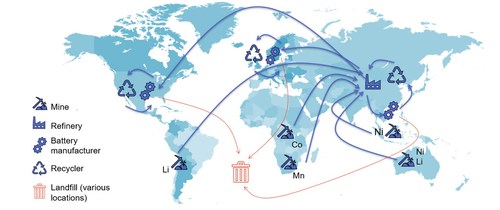IDTechEx have forecasted lithium-ion battery demand to reach over 2500 GWh for electric vehicles alone. However, the uptake of lithium-ion batteries is not without cost - they still present both technological and environmental problems.
 World Energy Storage Day: Fixing Flaws in Li-ion Batteries
World Energy Storage Day: Fixing Flaws in Li-ion Batteries

Article from | IDTechEx
Energy storage is a key enabler for the ongoing electrification of carbon-intensive sectors, namely the automotive and energy industries. Developments in energy storage are driven by the increased uptake of EVs and the balancing of renewable electricity grids to provide power during low solar and wind periods. IDTechEx have developed a comprehensive portfolio of energy storage research to help clients make strategic business decisions and capitalize from these innovations, which can be found from www.IDTechEx.com/Research/ES.
Energy-dense battery technologies like lithium-ion have opened new avenues for portable electronic devices, electric mobility, and stationary storage. IDTechEx have forecasted lithium-ion battery demand to reach over 2500 GWh for electric vehicles alone. However, the uptake of lithium-ion batteries is not without cost - they still present both technological and environmental problems.
Recycling and the circular economy
Mining cobalt and lithium for lithium-ion batteries is far from environmentally friendly. Most cobalt comes from mines in the Democratic Republic of Congo, where mining pollution issues are compounded by human-rights violations. Lithium mining has a big impact on regions with scarce water reserves due to the large amounts of water the extraction process requires. There are further environmental implications of the traditional battery supply chain when considering the route by land and sea that some materials travel before reaching the battery cell manufacturer to form finished products.
Recycling solves this problem by 'closing the loop' in the supply chain. Companies can recover valuable metals from end-of-life batteries and scrap from battery manufacturing and are currently developing more environmentally friendly processes to do so. Recyclers profiled by IDTechEx, including Battery Resourcers and American Manganese, employ acid leaching and solvent extraction in their hydrometallurgical processes. These processes have lower energy requirements than purely pyrometallurgical techniques used by recyclers in the past, which involve smelting the metal down causing value to be lost. This solution can be further optimized by co-locating battery recycling facilities with manufacturing facilities to allow more recycling of production scrap.
Increasing circularity in the lithium-ion battery supply chain will reduce environmental concerns of the technology. However, further action must be taken to improve the sustainability of battery metal mining until there are sufficient quantities circulating the supply network. Additionally, as battery chemistries develop, recyclers will have to adjust their processes accordingly, and wasting undesirable metals may be inevitable.
The IDTechEx reports "The Li-ion Battery Supply Chain 2020-2030" and "Li-ion Battery Recycling: 2020-2040" address Li-ion battery supply chain and recycling landscape.
Advanced lithium and beyond
Lithium-ion batteries are slowly reaching their performance limits. There is always a trade-off between energy, power, and cycle life. Lithium-ion is a relatively well-developed technology, but alternatives such as solid-state, sodium-ion, and redox flow batteries bring fresh innovations to the area.
In solid-state batteries, the flammable liquid electrolyte is replaced with solid alternatives, creating safer batteries. Generally, the most popular types are oxide, sulfide, and polymer systems but there are various other solutions each with their own advantages and disadvantages. They can be compatible with high voltage cathode materials and high-capacity lithium metal anodes, making it possible to push the energy density beyond 1000 Wh/L in addition to improving safety. IDTechEx predict that the solid-state battery market will impact the supply chain, reaching over $8 billion by 2031. For more details on solid-state batteries, please feel free to refer to the IDTechEx report "Solid-State and Polymer Batteries 2021-2031: Technology, Forecasts, Players".
Beyond lithium, sodium-ion batteries have gained interest lately, in part due to CATLs public entry into the sodium-ion market. These batteries have the potential to achieve high-rate and long cycle life. However, sodium is a larger ion so energy density is lower, though the gravimetric energy density of sodium-ion cells can be comparable to LFP type Li-ion. In comparison to lithium, sodium is more readily available and democratically spread out across the world. A further advantage of sodium-ion is that it operates via similar fundamental operating principles as lithium-ion so that commercialization may be accelerated if learnings from lithium-ion development can be transferred.
Redox Flow Batteries (RFBs) are a non-toxic and non-flammable stationary storage alternative to lithium-ion batteries where power and energy can be scaled independently. This greater level of safety, coupled with longer cycle lives and better suitability for long-duration storage means IDTechEx foresee a large adoption of RFBs toward the end of the next decade, as described in the updated report, "Redox Flow Batteries 2021-2031". In the past, RFBs have struggled to compete against the well-established lithium-ion batteries however this is changing, and in this report update, IDTechEx explains and addresses the possible roles which the redox flow battery will play in the future.
More to explore
Lithium-ion has established itself as a key technology and enabler of the energy transition but is not a complete solution. Further progress needs to be made in developing a circular economy and tackling the competing factors within lithium-ion batteries to further improve performance metrics. Energy storage technologies beyond lithium-ion can also play a role, especially for stationary energy storage systems.
For a further understanding on these topics, please refer to the following IDTechEx reports:
- Lithium-ion Batteries for Electric Vehicles 2021-2031
- Batteries for Stationary Energy Storage 2021-2031
- Li-ion Battery Recycling: 2020-2040
- Solid-State and Polymer Batteries 2021-2031: Technology, Forecasts, Players
- Redox Flow Batteries 2021-2031
About IDTechEx
IDTechEx guides your strategic business decisions through its Research, Subscription and Consultancy products, helping you profit from emerging technologies. For more information, contact research@IDTechEx.com or visit www.IDTechEx.com.
The content & opinions in this article are the author’s and do not necessarily represent the views of AltEnergyMag
Comments (0)
This post does not have any comments. Be the first to leave a comment below.
Featured Product


